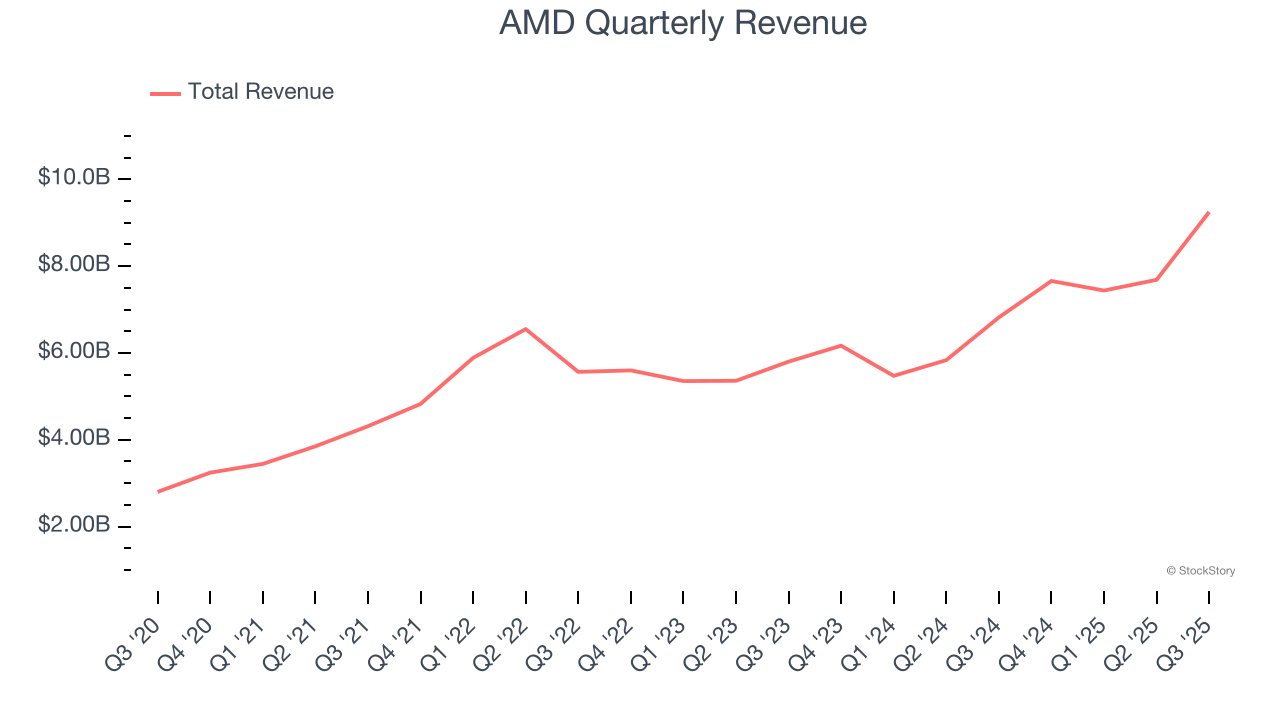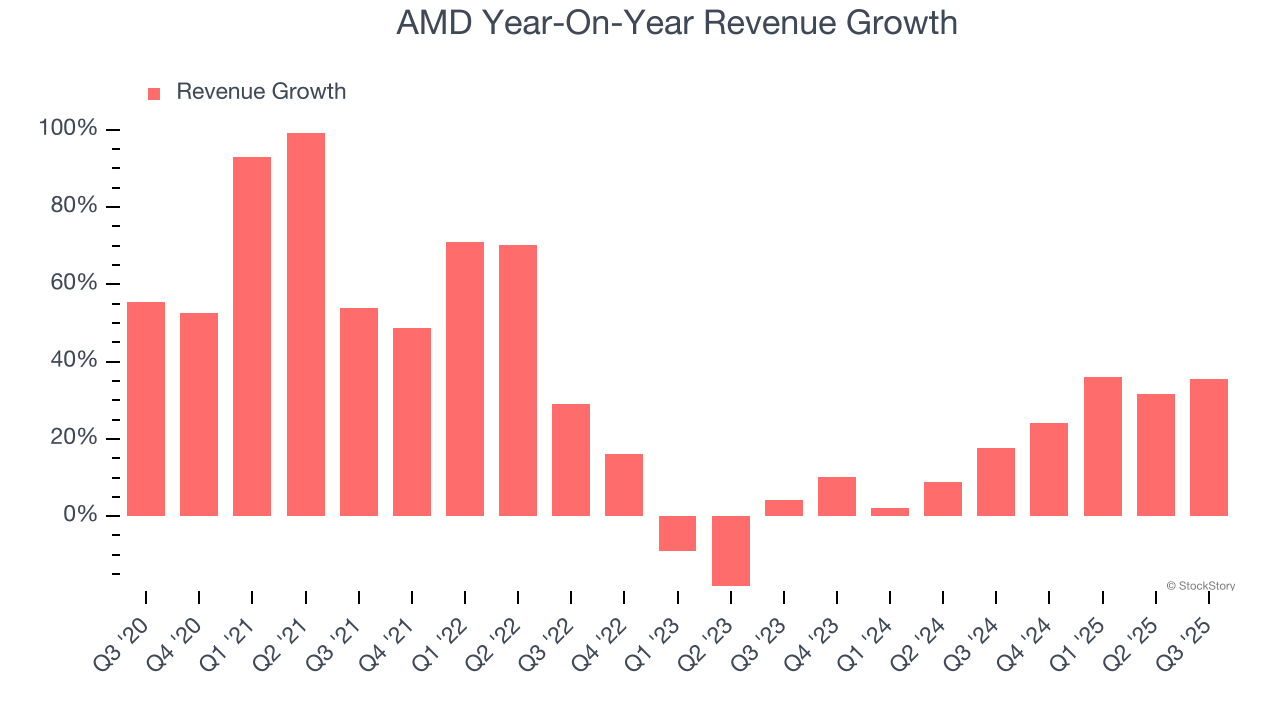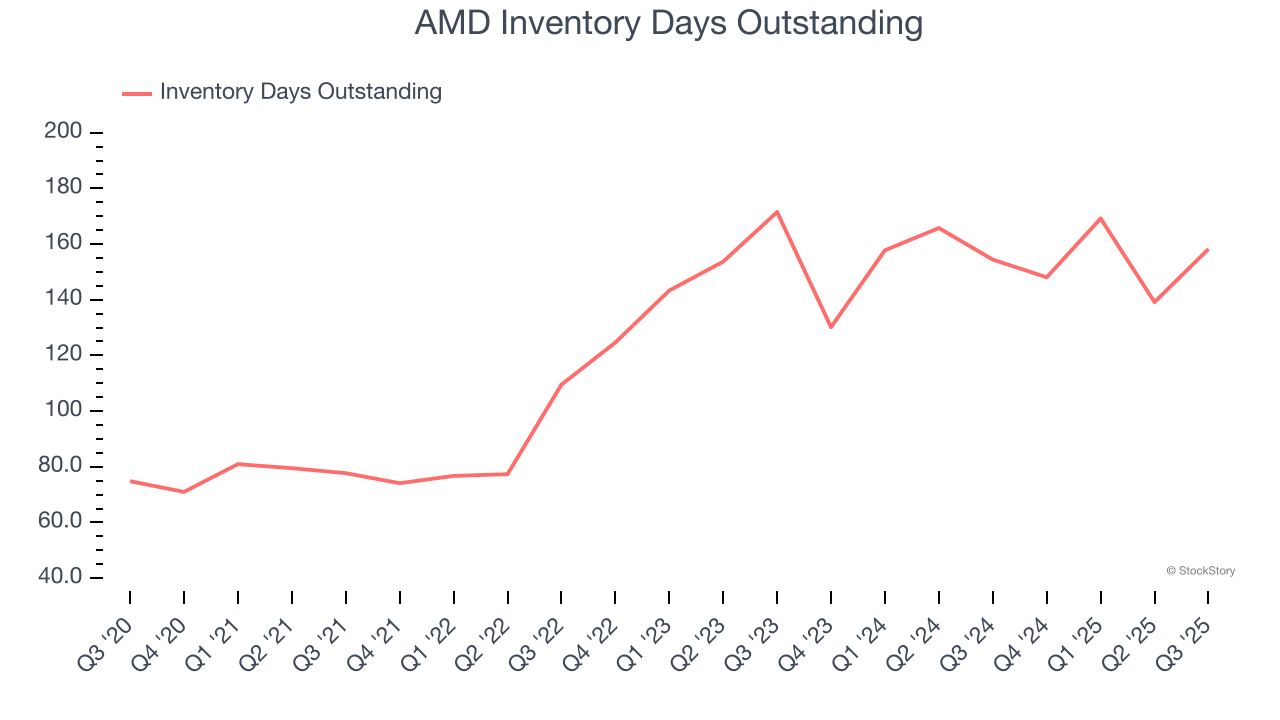
Computer processor maker AMD (NASDAQ: AMD) reported Q3 CY2025 results topping the market’s revenue expectations, with sales up 35.6% year on year to $9.25 billion. On top of that, next quarter’s revenue guidance ($9.6 billion at the midpoint) was surprisingly good and 4.7% above what analysts were expecting. Its non-GAAP profit of $1.20 per share was 2.4% above analysts’ consensus estimates.
Is now the time to buy AMD? Find out by accessing our full research report, it’s free for active Edge members.
AMD (AMD) Q3 CY2025 Highlights:
- Revenue: $9.25 billion vs analyst estimates of $8.76 billion (35.6% year-on-year growth, 5.6% beat)
- Adjusted EPS: $1.20 vs analyst estimates of $1.17 (2.4% beat)
- Adjusted EBITDA: $2.43 billion vs analyst estimates of $2.11 billion (26.3% margin, 15.5% beat)
- Revenue Guidance for Q4 CY2025 is $9.6 billion at the midpoint, above analyst estimates of $9.17 billion
- Operating Margin: 13.7%, up from 10.6% in the same quarter last year
- Free Cash Flow Margin: 16.5%, up from 7.3% in the same quarter last year
- Inventory Days Outstanding: 158, up from 139 in the previous quarter
- Market Capitalization: $421.4 billion
"We delivered an outstanding quarter, with record revenue and profitability reflecting broad based demand for our high-performance EPYC and Ryzen processors and Instinct AI accelerators," said Dr. Lisa Su, AMD chair and CEO.
Company Overview
Founded in 1969 by a group of former Fairchild semiconductor executives led by Jerry Sanders, Advanced Micro Devices (NASDAQ: AMD) is one of the leading designers of computer processors and graphics chips used in PCs and data centers.
Revenue Growth
A company’s long-term sales performance can indicate its overall quality. Any business can put up a good quarter or two, but the best consistently grow over the long haul. Thankfully, AMD’s 29.9% annualized revenue growth over the last five years was incredible. Its growth beat the average semiconductor company and shows its offerings resonate with customers, a helpful starting point for our analysis. Semiconductors are a cyclical industry, and long-term investors should be prepared for periods of high growth followed by periods of revenue contractions.

We at StockStory place the most emphasis on long-term growth, but within semiconductors, a half-decade historical view may miss new demand cycles or industry trends like AI. AMD’s annualized revenue growth of 20.4% over the last two years is below its five-year trend, but we still think the results suggest healthy demand. 
This quarter, AMD reported wonderful year-on-year revenue growth of 35.6%, and its $9.25 billion of revenue exceeded Wall Street’s estimates by 5.6%. Beyond the beat, this marks 9 straight quarters of growth, showing that the current upcycle has had a good run - a typical upcycle usually lasts 8-10 quarters. Company management is currently guiding for a 25.4% year-on-year increase in sales next quarter.
Looking further ahead, sell-side analysts expect revenue to grow 21.3% over the next 12 months, similar to its two-year rate. This projection is eye-popping for a company of its scale and implies the market sees success for its products and services.
The 1999 book Gorilla Game predicted Microsoft and Apple would dominate tech before it happened. Its thesis? Identify the platform winners early. Today, enterprise software companies embedding generative AI are becoming the new gorillas. a profitable, fast-growing enterprise software stock that is already riding the automation wave and looking to catch the generative AI next.
Product Demand & Outstanding Inventory
Days Inventory Outstanding (DIO) is an important metric for chipmakers, as it reflects a business’ capital intensity and the cyclical nature of semiconductor supply and demand. In a tight supply environment, inventories tend to be stable, allowing chipmakers to exert pricing power. Steadily increasing DIO can be a warning sign that demand is weak, and if inventories continue to rise, the company may have to downsize production.
This quarter, AMD’s DIO came in at 158, which is 35 days above its five-year average, suggesting that the company’s inventory has grown to higher levels than we’ve seen in the past.

Key Takeaways from AMD’s Q3 Results
We enjoyed seeing AMD beat analysts’ revenue, EPS, and EBITDA expectations this quarter. We were also glad its revenue guidance for next quarter exceeded Wall Street’s estimates. On the other hand, its inventory levels materially increased. Overall, we think this was a decent quarter with some key metrics above expectations. Investors were likely hoping for more, and shares traded down 1.2% to $247.23 immediately after reporting.
Big picture, is AMD a buy here and now? The latest quarter does matter, but not nearly as much as longer-term fundamentals and valuation, when deciding if the stock is a buy. We cover that in our actionable full research report which you can read here, it’s free for active Edge members.





